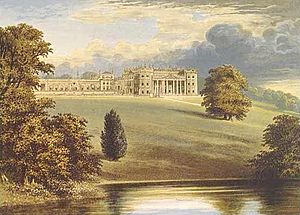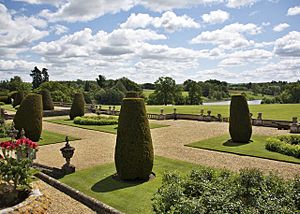Bowood House facts for kids
Bowood is a beautiful old country house in Wiltshire, England. It's been owned by the Fitzmaurice family for over 250 years. The house has special rooms designed by Robert Adam. Its huge gardens were planned by a famous landscape designer called Lancelot "Capability" Brown. Bowood is near the village of Derry Hill, between Calne and Chippenham. A big part of the house was taken down in 1956.
Since 1754, Bowood has been the home of the Earls of Shelburne. They later became the Marquesses of Lansdowne in 1784. The current Marquess is Charles Petty-Fitzmaurice. Important visitors like Benjamin Franklin and Mirabeau (a leader of the French Revolution) have stayed here.
Contents
A Look Back in Time
The first house at Bowood was built around 1725. It was on the spot of an old hunting lodge. Sir Orlando Bridgeman, who used to rent the land, bought it from the King. But he ran into money problems. In 1739, Richard Long, who he owed money to, took over the house and park.
In 1754, Richard Long sold Bowood to the first Earl of Shelburne. He hired an architect named Henry Keene to make the house bigger.
Changes and Famous Guests
William Petty, the second Earl of Shelburne, became Prime Minister of Britain from 1782 to 1783. He was made the Marquess of Lansdowne for helping to make peace with America after the American War of Independence. He filled Bowood with amazing paintings and old sculptures. He also asked Robert Adam to decorate the grand rooms. Adam added a large orangery, which is like a greenhouse for orange trees. He also built a small zoo with a leopard and an orangutan! Adam also created a beautiful mausoleum (a building for burials) in the park for the first earl.
In the 1770s, the two parts of Bowood House were joined together. This was done by building a huge drawing room.
The House Through the Wars
During World War I, the fifth Marchioness turned the orangery into a hospital. In World War II, a school and then the Royal Air Force used the main part of the house. After the war, it was left empty. By 1955, it was in such bad shape that the eighth Marquess decided to take it down. He hired an architect to make the smaller part of the house more comfortable to live in. Many large country houses were demolished around this time.
Before the main house was taken down, its Adam dining room was sold. It was bought by Lloyd's of London, a big insurance company. They took the room apart and rebuilt it in their London office. It was moved again in 1986 to their current building. A grand entrance from the house was also moved to Roath Court in Cardiff.
The mausoleum was given a special Grade I listing in 1960. The remaining parts of the main house got the same important status in 1972. This means they are very important historic buildings.
Bowood Today
The house that remains is still very large. The front part is open to visitors. You can see rooms, paintings, and sculptures there. One special room was the laboratory of Joseph Priestley. He discovered oxygen there on August 1, 1774! In 2000, Bowood House was recognized as an important chemical landmark because of Priestley's discovery.
It was found that a village called Manning's Hill was flooded to create the lake. It is still underwater today. In 2007, divers found the remains of two cottages and stone walls under the water.
The grounds also have an adventure playground for younger children. There's a large waterfall and many gardens. In May and June, you can walk through two miles of rhododendrons. In spring, there are fields of daffodils, narcissi, and bluebells.
The Beautiful Park and Gardens
Bowood's huge park was designed in the 1760s. It covers over 2,000 acres (about 8 square kilometers). It replaced an older, more formal garden. Capability Brown's design includes a winding lake, almost 1 kilometer long. Lawns gently slope down from the house, with groups of old trees. Under the lake are the foundations of the cottages from Manning's Hill village. Divers found them in 2007.
Brown planted many rare trees in the Pleasure Grounds behind the walled garden. More trees were added in the mid-1800s when a pinetum (a collection of pine trees) was started. Around this time, the Doric Temple, a decorative building, was moved to its spot by the lake.
In 1766, Lady Shelburne visited another famous garden. She then asked Charles Hamilton to improve Capability Brown's design at Bowood. Working with Josiah Lane, Hamilton added a waterfall, grottoes (small caves), and a hermit's cave by the lake in the 1780s.
The Italian-style terrace gardens on the south side of the house were added later. The Upper Terrace was finished in 1818. The Lower Terrace was added in 1851. These gardens used to have hundreds of thousands of flowers in fancy patterns. Now, they are planted more simply.
In 1987, the formal garden, pleasure ground, park, and woods were given a Grade I listing. This means they are very important historic landscapes. A golf course was built in the west part of the park in the late 1990s. A hotel opened nearby in 2009.
The Lansdowne Family at Bowood
Bowood House is the grand home of the Lansdowne family. Many members of the family have lived here, including:
- John Petty, 1st Earl of Shelburne (1706–1761)
- William Petty Fitzmaurice, 2nd Earl of Shelburn & 1st Marquess of Lansdowne (1737–1805)
- John Henry Petty Fitzmaurice, 2nd Marquess of Lansdowne (1765–1809)
- Henry Petty-Fitzmaurice, 3rd Marquess of Lansdowne (1780–1863)
- Henry Charles Petty-Fitzmaurice, 4th Marquess of Lansdowne (1816–1866)
- Henry Charles Keith Petty-Fitzmaurice, 5th Marquess of Lansdowne (1845–1927)
- Henry William Edmund Petty-Fitzmaurice, 6th Marquess of Lansdowne (1872–1936)
- Charles Hope Petty-Fitzmaurice, 7th Marquess of Lansdowne (1917–1944)
- George John Charles Petty-Fitzmaurice, 8th Marquess of Lansdowne (1912–1999)
- Charles Petty-Fitzmaurice, 9th Marquess of Lansdowne (born 1941)
- Simon Henry George Petty-Fitzmaurice, Earl of Kerry (born 1970)









